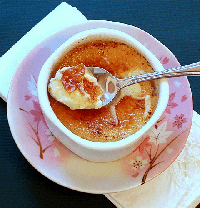 After baking, the Crème Brûlée custard gets a crackly caramel topping made from caramelized sugar. It is its distinguishing feature. Sugar is spread over the top of the baked custard, and then melted. It turns to caramel which, when cool, becomes very brittle. A blowtorch makes quick work of caramelizing the sugar topping, but the broiler works, too.
After baking, the Crème Brûlée custard gets a crackly caramel topping made from caramelized sugar. It is its distinguishing feature. Sugar is spread over the top of the baked custard, and then melted. It turns to caramel which, when cool, becomes very brittle. A blowtorch makes quick work of caramelizing the sugar topping, but the broiler works, too.
We use this how to baking technique with the Classic Creme Brulee Recipe.
HOW TO:
The Broiler Method
This method is only successful with a very hot broiler in a gas oven (electric ovens don't seem to provide heat high enough to caramelize the sugar). I prefer to caramelize sugar this way. Position the top oven shelf so that the flame is 2 to 3 inches away from the top of the custard dish or ramekins (small custard dishes). Don't turn on the oven yet.
Line a large, rimmed baking pan with a towel to keep the baked custard from sliding around. Pull out the top shelf of the oven and place the baking pan on top. Arrange the custard dish or ramekins (small custard dishes) on top. Fill the spaces around each with ice (as best you can) and add water so that they're surrounded by ice water. The ice water will keep the custard cold and creamy while the top is being caramelized under the broiler.
Sift a thin, even layer of sugar on the surface of the custard or each ramekin and gently slide the shelf in so they are under the broiler. Watch carefully: within three or four minutes, the sugar will melt and then caramelize. Remove the baking dish and take out the custard dish(es).
With the custard dish(es) bathed in ice water, the custard stays cold and creamy while the topping caramelizes under the broiler.
The Kitchen Torch Method
You can caramelize sugar on a Crème Brûlée with a mini propane blowtorch. They are sold in most hardware stores, with good ones going for around $30. (Williams-Sonoma carries one). I highly recommend buying one with an automatic ignition, which allows you to light the torch with the press of a button — no matches needed.
Sift a thin, even layer of sugar over the refrigerated custards, ignite the torch, and with a slow, sweeping motion, guide the flame directly on the surface of the custard. The nozzle should be 2 to 3 inches from the surface, with the tip of the flame licking the sugar. The sugar will melt slowly at first and then caramelize. As soon as the entire surface is glossy brown, move on to the next custard.


